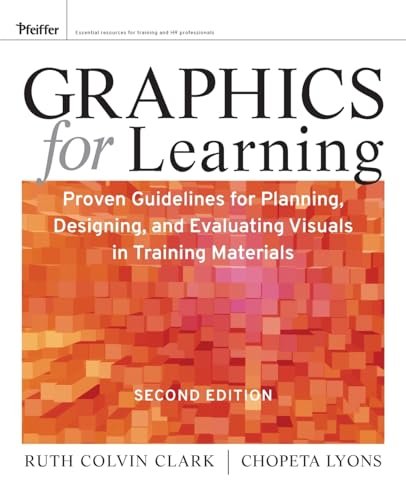
ISBN: 9780470547441
2nd Edition, by Ruth C. Clark; Chopeta Lyons, PRINT ISBN: 9780470547441 E-TEXT ISBN: 9780470880920 Additional ISBNs: 9780470880906, 9780470880890, 9781299186217 Wiley Professional Develo… Mehr…
| VitalSource.com new in stock United Kingdom. Versandkosten:plus shipping costs., zzgl. Versandkosten Details... |

Graphics for Learning: Proven Guidelines for Planning, Designing, and Evaluating Visuals in Training Materials - Taschenbuch
2010, ISBN: 0470547448
[EAN: 9780470547441], Used, good, [SC: 27.77], [PU: Pfeiffer], US Edition Textbook, May Have Highlights, Notes and/or Underlining, BOOK ONLY-NO ACCESS CODE, NO CD, Ships with Emailed Trac… Mehr…
| AbeBooks.co.uk SGS Trading Inc, Franklin Lakes, NJ, U.S.A. [54851437] [Rating: 5 (of 5)] NOT NEW BOOK. Versandkosten: EUR 27.77 Details... |

Graphics for Learning: Proven Guidelines for Planning, Designing, and Evaluating Visuals in Training Materials, 2nd Edition - Taschenbuch
2010, ISBN: 0470547448
[EAN: 9780470547441], Used, good, [SC: 39.67], [PU: Pfeiffer], Good Condition; may contain minimal marking or notes to text; wear to cover; minor water or liquid damage not affecting the … Mehr…
| AbeBooks.co.uk William Michael Books, Cave Springs, AR, U.S.A. [64756890] [Rating: 5 (of 5)] NOT NEW BOOK. Versandkosten: EUR 39.67 Details... |

Graphics for Learning: Proven Guidelines for Planning, Designing, and Evaluating Visuals in Training Materials - Taschenbuch
ISBN: 9780470547441
Paperback / softback. New. This second edition of the bestselling book summarizes guidelines for best use of graphics for instructional materials, including multimedia, texts, classroom … Mehr…
| Biblio.co.uk |

Graphics for Learning: Proven Guidelines for Planning, Designing, and Evaluating Visuals in Training Materials, 2nd Edition - Taschenbuch
2010, ISBN: 0470547448
[EAN: 9780470547441], New book, [SC: 23.8], [PU: Pfeiffer], Buy for Great customer experience, Books
| AbeBooks.co.uk GoldenDragon, Houston, TX, U.S.A. [83663787] [Rating: 5 (of 5)] NEW BOOK. Versandkosten: EUR 23.80 Details... |

Graphics for Learning: Proven Guidelines for Planning Designing and Evaluating Visuals in Training Materials - 2nd Edition (eBook) - neues Buch
ISBN: 9780470547441
2nd Edition, by Ruth C. Clark; Chopeta Lyons, PRINT ISBN: 9780470547441 E-TEXT ISBN: 9780470880920 Additional ISBNs: 9780470880906, 9780470880890, 9781299186217 Wiley Professional Develo… Mehr…

Clark, Ruth C.; Lyons, Chopeta:
Graphics for Learning: Proven Guidelines for Planning, Designing, and Evaluating Visuals in Training Materials - Taschenbuch2010, ISBN: 0470547448
[EAN: 9780470547441], Used, good, [SC: 27.77], [PU: Pfeiffer], US Edition Textbook, May Have Highlights, Notes and/or Underlining, BOOK ONLY-NO ACCESS CODE, NO CD, Ships with Emailed Trac… Mehr…

Graphics for Learning: Proven Guidelines for Planning, Designing, and Evaluating Visuals in Training Materials, 2nd Edition - Taschenbuch
2010
ISBN: 0470547448
[EAN: 9780470547441], Used, good, [SC: 39.67], [PU: Pfeiffer], Good Condition; may contain minimal marking or notes to text; wear to cover; minor water or liquid damage not affecting the … Mehr…
Graphics for Learning: Proven Guidelines for Planning, Designing, and Evaluating Visuals in Training Materials - Taschenbuch
ISBN: 9780470547441
Paperback / softback. New. This second edition of the bestselling book summarizes guidelines for best use of graphics for instructional materials, including multimedia, texts, classroom … Mehr…

Graphics for Learning: Proven Guidelines for Planning, Designing, and Evaluating Visuals in Training Materials, 2nd Edition - Taschenbuch
2010, ISBN: 0470547448
[EAN: 9780470547441], New book, [SC: 23.8], [PU: Pfeiffer], Buy for Great customer experience, Books
Bibliographische Daten des bestpassenden Buches
| Autor: | |
| Titel: | |
| ISBN-Nummer: |
Detailangaben zum Buch - Graphics for Learning
EAN (ISBN-13): 9780470547441
ISBN (ISBN-10): 0470547448
Taschenbuch
Erscheinungsjahr: 2010
Herausgeber: John Wiley & Sons Inc
399 Seiten
Gewicht: 0,773 kg
Sprache: eng/Englisch
Buch in der Datenbank seit 2011-04-26T20:41:32+02:00 (Zurich)
Detailseite zuletzt geändert am 2024-02-17T19:22:40+01:00 (Zurich)
ISBN/EAN: 9780470547441
ISBN - alternative Schreibweisen:
0-470-54744-8, 978-0-470-54744-1
Alternative Schreibweisen und verwandte Suchbegriffe:
Autor des Buches: lyons ruth, clark, pfeiffer
Titel des Buches: planning and evaluating, training material, learning designing, visual learning, learning how ask, graphics for learning, visuals
Daten vom Verlag:
Autor/in: Ruth C. Clark; Chopeta Lyons
Titel: Graphics for Learning - Proven Guidelines for Planning, Designing, and Evaluating Visuals in Training Materials
Verlag: John Wiley & Sons
420 Seiten
Erscheinungsjahr: 2010-11-19
Gewicht: 0,775 kg
Sprache: Englisch
79,90 € (DE)
No longer receiving updates
202mm x 233mm x 21mm
BC; Paperback; Hardcover, Softcover / Wirtschaft/Betriebswirtschaft; Personalmanagement, HRM; Business & Management; Personalentwicklung; Consulting; Training u. Personalentwicklung; Training & Development; Wirtschaft u. Management; Consulting; Training u. Personalentwicklung
On the Web. Acknowledgments. Foreword to the Second Edition. Introduction: Getting the Most from This Resource. Section One: The Foundation. Chapter 1. The Power of Visuals. The Unrealized Potential of Visuals. What Is a Graphic? Which Visuals Are Best? No Yellow Brick Road. Graphics in the Instructional Landscape. Chapter 2. Three Views of Instructional Visuals. Three Views of Visuals. Communication Functions of Graphics. Graphics to Support Psychological Events of Learning. Our Guiding Principles. Chapter 3. A Visual Design Model for Planning Graphics Systematically. Three Facets of Graphics. What Can Happen Without a Systematic Approach. What Happens When Instructional Designers Follow a Systematic Process. A Visual Design Model. Section Two. How to Use Visuals to Support Psychological Learning Processes. Chapter 4. Graphics and Learning. Not All Graphics Are Equal. Graphics and Learning. A Tale of Two Memories. Unique Brain Storage for Visual Information. How Learning Happens. How Graphics Promote Learning. Chapter 5. Plan Graphics That Direct Attention. Attention, Learning, and Graphics. Guideline 1: Use Signals to Focus Attention. Guideline 2: Use Color and Contrast to Focus Attention. Guideline 3: Use Motion Cues in Animation. Guideline 4: Use Color to Improve Job Performance. Graphics and Divided Attention. Guideline 5: Place Text Close to the Visuals It Describes. Guideline 6: Avoid Distracting Visuals. Chapter 6. Plan Visuals That Leverage Prior Knowledge. Prior Knowledge, Learning, and Graphics. Guideline 1: Use Comparative Advance Organizers. Guideline 2: Use Expository Advance Organizers. Guideline 3: Avoid Seductive Details in Lesson Introductions. Chapter 7. Plan Graphics That Minimize Irrelevant Mental Load. What Is Mental Load? Guideline 1: Use Graphics Rather Than Text for Special Content. Guideline 2: Use Simpler Graphics for Deeper Learning. Guideline 3: Use Animations to Teach Hands-On Skills. Guideline 4: Explain Complex Graphics with Words in Audio. Guideline 5: Use Words or Graphics Alone When Information Is Self-Explanatory. Guideline 6: Use Previews and Overlays with Complex Visuals. Chapter 8. Plan Graphics to Help Learners Build Mental Models. Mental Modeling, Learning, and Graphics. Guideline 1: Use Organizational Graphics to Show Quantitative Relationships. Guideline 2: Use Charts and Graphs to Communicate Quantitative Relationships. Guideline 3: Use Transformational Visuals to Communicate Changes in Time or Space. Guideline 4: Use Interpretive Visuals to Communicate Abstract Cause-and-Effect. Relationships. Use Animated Online Agents to Model Thinking Processes. Chapter 9. Plan Graphics That Support Transfer of Learning. Transfer and Work Performance. Near- Versus Far-Transfer Tasks. Context Is King for Near-Transfer Tasks. Guideline 1: Use Dynamic Visuals That Reflect Workplace Context for Procedures. Guideline 2: Incorporate Workplace Context in 3D Worlds. Mental Models Are King in Far-Transfer Tasks. Guideline 3: Use Static Visuals to Illustrate How Things Work. Guideline 4: Use Dynamic Visuals for Interpersonal Skills. Guideline 5: Use Varied Context Visual Examples for Deeper Understanding. Guideline 6: Use Workplace Context Visuals for Immersive Learning Environments. Chapter 10. Plan Graphics for Motivation and Learning. Motivation and Learning. Interest and Motivation. Guideline 1: Use Dynamic Visuals That Display Work Concepts. Guideline 2: Leverage Social Presence Through Learning Agents in Asynchronous Multimedia. Guideline 3: Consider Using Relevant Trigger Visuals to Catch Initial Interest. Guideline 4: Minimize Graphics Used Soley as Eye Candy. Chapter 11. Plan Graphics to Leverage Learner Differences. Different Strokes for Different Folks? Guideline 1: Drop the Myth of Visual Learning Style. Guideline 2: Emphasize Visuals for Beginners. Guideline 3: Provide Just-in-Time Training to Help Learners Interpret Complex Visuals. Guideline 4: Encourage All Learners to Process Visuals Effectively. Section Three. How to Visualize Lesson Content. Chapter 12. How to Visualize Procedures. What Are Procedures? Teaching Procedures. Guideline 1: Combine Representational and Transformational Visuals in Demonstrations. Guideline 2: Demonstrate Procedures with Dynamic Visuals. Guideline 3: Manage Mental Load. Guideline 4: Use Visuals to Draw Attention to Warnings. Guideline 5: Design Online Practice Exercises Effectively. Chapter 13. How to Visualize Concepts. What Are Concepts? Teaching Concepts. How to Visualize Concepts. Guideline 1: Display Teaching Methods in a Contiguous Manner. Guideline 2: Create Visual Counterexamples. Guideline 3: Use Visual Analogies. Guideline 4: Display Related Concepts Together. Guideline 5: Use organizational Visuals for Related Concepts. Guideline 6: Promote Learner Engagement with Concept Visuals. Chapter 14. How to Visualize Facts. What Are Facts? Teaching Facts. How to Help Learners to Visualize Facts. Guideline 1: Use Representational Visuals Displayed in Job Context. Guideline 2: Display Facts with Visual Contiguity. Guideline 3: Use Organizational Visuals. Guideline 4: Use Relational Visuals for Numeric Trends. Guideline 5: Promote Engagement with Important Factual Visuals. Chapter 15. How to Visualize Processes. What Are Processes? Who Needs Process Knowledge? Teaching Processes. How to Help Learners to Visualize Processes. Guideline 1: Use Transformational Visuals That Show State Changes. Guideline 2: Use Simpler Visuals to Promote Understanding. Guideline 3: Manage Load When Presenting Process Visuals. Guideline 4: Use Interpretive Visuals to Represent Abstract Processes. Guideline 5: Promote Engagement with Process Visuals. Chapter 16. How to Visualize Principles. What Are Principles? What Are Principles? Problem-Centered Learning Environments. Components of Problem-Centered Learning Environments. When to Consider Problem-Centered Learning. Inductive Learning from Case Examples. Teaching Principles as Laws or Theories. How to Visualize Principles. Guideline 1: Use Representational Visuals for Problem-Centered Learning Components. Guideline 2: Use Multimedia Dynamic Visuals for Case Scenarios. Guideline 3: Use Animated Agents to Model Critical Thinking Skills. Guideline 4: Use Graphic Design Devices to Manage Mental Load During Problem-Centered Learning. Guideline 5: Analyze Video or Audio Recorded Work Samples. Guideline 6: Engage Learners with Explanatory Visuals, Including Virtual Simulations. Section Four. How to Plan and Communicate Your Visuals. Chapter 17. Determine the Context. The Realities of the Workplace. What to Decide and When. Assess the Learning Landscape. Consider Production. Chapter 18. Design Your Visual Approach. Getting the Right Artist. Designing the Visual Approach. Treatment Meeting. What to Consider. Rough It Out--Style and Available Real Estate. A Semi-Fictional Case Study. Chapter 19. Visualize Individual Graphics. Creating Individual Visuals That Work. A Case Study Continued: Sanji's Graphic. Chapter 20. Communicate and Lay Out Graphic Plans. Who Needs to Know. Communicating the Visual Approach, the "Look and Feel". Communicating Ideas for the Development of Individual Graphics. Communicating Layout Plans. Communicating Graphics to Production Staff. Case Study: Sanji Talks to the Artist. Chapter 21. Apply the Principles. The End-User System Application Training. The Investment Club's Financial Basics Training. Glossary. References. About the Authors. List of Figures and Tables. Index.Weitere, andere Bücher, die diesem Buch sehr ähnlich sein könnten:
Neuestes ähnliches Buch:
2900470547440 Graphics for Learning: Proven Guidelines for Planning, Designing, and Evaluating Visuals in Training Materials (Ruth C. Clark)
- 2900470547440 Graphics for Learning: Proven Guidelines for Planning, Designing, and Evaluating Visuals in Training Materials (Ruth C. Clark)
- 9780470880890 Graphics for Learning (Ruth C. Clark; Chopeta Lyons)
- 9780470880920 Graphics for Learning (Ruth C. Clark, Chopeta Lyons)
- 9780787969943 Graphics for Learning (Clark)
< zum Archiv...



